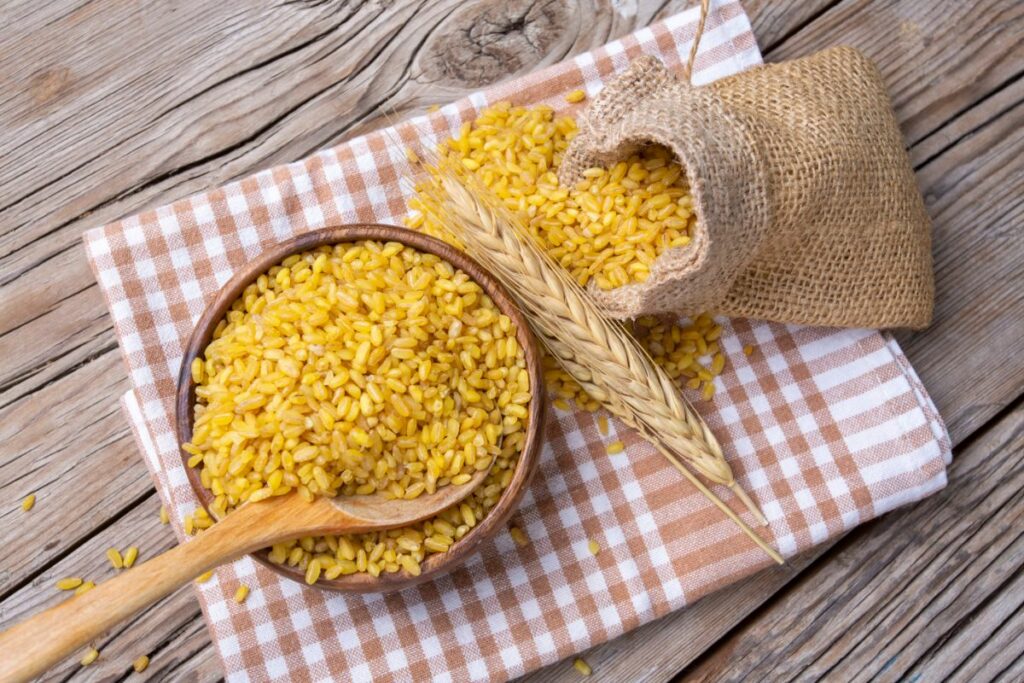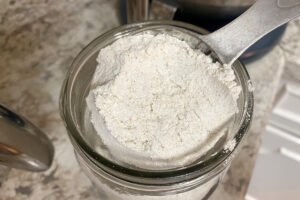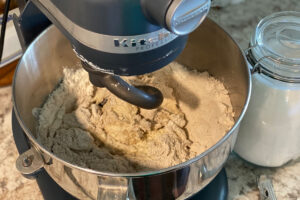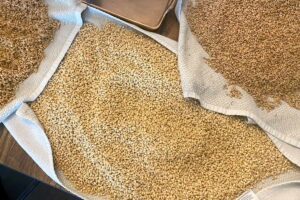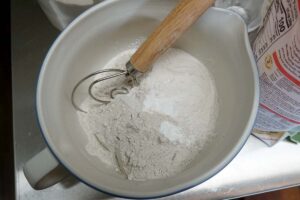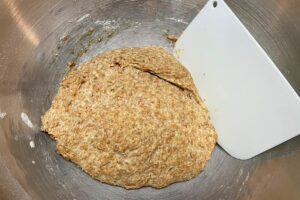Bulgur wheat has been a staple in Middle Eastern cuisine for centuries, and it’s becoming increasingly popular around the world. Why? Because not only is it delicious and versatile, but it’s also packed with health benefits. As a high-fiber grain, Bulgur wheat can help improve your digestive health keep you feeling full longer.
- Nutritional profile: High in fiber and protein, and a good source of vitamins and minerals, including manganese, magnesium, and iron
- Cooking and texture: Cooks quickly, has a tender, slightly chewy texture
- Flavor: Nutty, with a mild wheat flavor
- Use in cuisine: Common in Middle Eastern cuisine; used in dishes like tabbouleh, pilafs, and as a stuffing ingredient
- A partial whole grain: It is made from Durum wheat and has the outer bran removed, making it not a full whole grain since it doesn’t include all three parts of the wheat berry
In this article, we’ll explore everything you need to know about Bulgur wheat, from its nutritional profile to the best cooking methods.
What is Bulgur wheat
Origin and characteristics
Bulgur wheat is made from Durum wheat, which is partially cooked, dried, and then cracked. The process involves cleaning the whole wheat kernels, parboiling (or steaming) them to partially cook, drying them, and then removing the bran. The grains are then cracked into various sizes, which can range from fine to coarse. This process pre-cooks the Bulgur, allowing it to cook quickly when used in recipes. The result is a nutritious, versatile grain with a nutty flavor and a chewy texture, commonly used in Middle Eastern, Mediterranean, and European cuisines.
Its origin can be traced back to Middle Eastern cuisine, where it’s commonly used in dishes like tabbouleh. I find that its texture is somewhat similar to Quinoa, with a mild, earthy, and nutty flavor that can easily complement various dishes.
Comparison to other grains
Quinoa
- Nutritional profile: A complete protein source, containing all nine essential amino acids; also high in fiber, vitamins, and minerals.
- Cooking and texture: Has a fluffy texture with a slightly crunchy and nutty flavor
- Flavor: Mild, nutty
- Use: Versatile; used in salads, sides, or as a rice substitute.
Brown rice
- Nutritional profile: Rich in fiber, vitamins, and minerals; lower in protein compared to quinoa and bulgur
- Cooking and texture: Chewier and nuttier than white rice.
- Flavor: Mild, nutty
- Use in cuisine: A staple in various cuisines; used similarly to white rice but offers more nutrients
Farro
- Nutritional profile: High in fiber, protein, and nutrients like magnesium, zinc, and some B vitamins.
- Cooking and texture: Chewy texture, more substantial than quinoa or couscous
- Flavor: Nutty and earthy.
- Use in cuisine: Popular in Italian cuisine; used in salads, soups, and risotto-like dishes
Unlike wheat berries, which are the raw version of whole wheat and take longer to prepare, bulgur cooks relatively quickly due to its parboiled nature. Similarly, it has a shorter cooking time than freekeh, another whole grain made from young green wheat kernels that are cracked but uncooked.
When it comes to nutrition, Bulgur wheat is high in fiber and protein, offering numerous health benefits such as aiding digestion, promoting satiety, and supporting overall wellness. Although Quinoa and some other whole grains like Farro may stand out for their protein content or unique nutrient profiles, Bulgur wheat’s affordability and cooking convenience make it a fantastic choice in day-to-day meal planning.
Nutritional profile of Bulgur wheat
Even though Bulgur wheat is derived from Durum wheat and has the nutrient-rich bran removed, it’s a great weeknight grain as it’s quick to prepare. In a 100 g (or 3.5 oz) serving of Bulgur wheat, you’ll find:
| Nutrient | Amount per 100g |
|---|---|
| Calories | 342 kcal |
| Protein | 12.29 g |
| Total Fat | 1.33 g |
| -Saturated Fat | 0.232 g |
| -Monounsaturated Fat | 0.167 g |
| -Polyunsaturated Fat | 0.577 g |
| Carbohydrates | 75.87 g |
| Dietary Fiber | 18.3 g |
| Sugars | 0.41 g |
| Vitamins & Minerals | |
| – Calcium | 35 mg |
| – Iron | 2.46 mg |
| – Magnesium | 164 mg |
| – Phosphorus | 300 mg |
| – Potassium | 410 mg |
| – Sodium | 17 mg |
| – Zinc | 1.93 mg |
| – Vitamin C | 0 mg |
| – Thiamin (B1) | 0.232 mg |
| – Riboflavin (B2) | 0.115 mg |
| – Niacin (B3) | 5.114 mg |
| – Vitamin B6 | 0.342 mg |
| – Folate (B9) | 27 μg |
| – Vitamin E | 0.06 mg |
| – Vitamin K | 2.2 μg |
Bulgur wheat is rich in vitamins and minerals. It’s a great source of manganese, magnesium, iron, and potassium. Manganese is essential for healthy metabolism, magnesium helps with nerve and muscle function, while iron is essential for transporting oxygen in our blood. Potassium is important for maintaining proper fluid balance and blood pressure in our body.
Bulgur wheat has a relatively low glycemic index (GI), making it a good choice for people looking to manage their blood sugar levels. The glycemic index measures how quickly a food raises blood glucose levels after being consumed. Foods with a lower GI are digested and absorbed more slowly, causing a slower and more gradual rise in blood sugar.
Bulgur’s GI is generally considered to be in the low to medium range, depending on the size of the grain and the processing method. This low GI is attributed to its high fiber content, which slows the absorption of carbohydrates into the bloodstream. This makes bulgur a suitable grain for those with diabetes or anyone monitoring their blood sugar levels.
Cooking Bulgur wheat
Cooking Bulgur wheat is quite simple and it’s a versatile grain that can be used as a substitute for rice, quinoa, or even couscous in many recipes. Originating from Middle Eastern and Mediterranean cuisines, bulgur is often used in dishes like tabbouleh and kibbeh and pairs well with salads and pilafs.
Here are some tips:
- There are different varieties of Bulgur: fine, medium, and coarse. Fine bulgur is often used for making dishes like kibbe, while medium and coarse varieties work well in salads and other whole grain recipes. The choice of Bulgur can affect the cooking method and time.
- Preparing Bulgur: For fine Bulgur, soak it in boiling water for about 10 minutes and let it fully absorb the liquid. This quick method results in a chewy texture that’s perfect for salads like tabbouleh. On the other hand, medium and coarse Bulgur need to be cooked in boiling water for 10-15 minutes on the stovetop, or left in a heatproof bowl with boiling water to soak for 20-30 minutes until all the water is absorbed and the grains are tender. Soaking the bulgur will give you a chewier texture, which also works great for salads, and it can be boiled from raw in soups and stews as an alternative to brown rice.
- Follow a 2:1 ratio: When I cook bulgur wheat, I typically use a 2:1 ratio of liquid to grain. This can be water or broth for added flavor. For example, for 1 cup of medium or coarse bulgur, I bring 2 cups of liquid to a boil, then add the bulgur, reduce the heat to low, and cover the pot to let it simmer until all the liquid is absorbed, which usually takes about 10-15 minutes. It’s a good idea to fluff the cooked bulgur with a fork to separate the grains and let it stand for 5 to 10 minutes before serving.
Bulgur wheat is not only a delicious and nutritious option, but also an easy-to-prepare grain that can be incorporated into various recipes, making it a staple in my kitchen. Try experimenting with different varieties and cooking methods to find the perfect texture and flavor for your dishes.
Storing Bulgur wheat
Storing bulgur wheat properly is essential to maintain its freshness and flavor. I’ve gathered some tips and best practices on how to store bulgur wheat to help you enjoy this high-fiber grain for longer periods.
First of all, after purchasing bulgur wheat, it’s a good idea to transfer it from its original packaging into an airtight container to ensure its freshness. Glass or BPA-free plastic containers with tight-fitting lids are excellent choices for this purpose.
When selecting a storage location for bulgur wheat, I always go for a cool, dry, and dark place, such as a pantry or a cupboard. The ideal temperature should be below 70°F (21°C) with low humidity levels to avoid any moisture, which can lead to spoilage.
If I plan to use my bulgur wheat regularly, like once a month, I keep it at room temperature. However, if I won’t be using it so frequently, I opt to store the airtight container in the freezer. It is important to note that bulgur wheat stored in the freezer may take a bit longer to cook, but it prolongs the shelf life significantly.
According to the Whole Grains Council, whole grain flours and meals with intact bran layers can last up to 1 to 3 months on a cool, dry pantry shelf. And if stored in the freezer, they can last up to 2 to 6 months. Although bulgur wheat is not flour, it’s still a processed grain, so following these guidelines should help maintain its quality and nutrition.
Remember, always check for any signs of spoilage before using your stored bulgur wheat. Discard any grains that show discoloration, have an odd smell, or if you notice any bugs or mold in the container.
Popular Bulgur Wheat Recipes
As a fan of high-fiber grains, I’ve come across several delicious recipes that feature bulgur wheat as the star ingredient. One of my all-time favorites is tabbouleh, a Levantine salad made with finely chopped parsley, tomatoes, onions, and mint. The bulgur wheat adds a wonderful texture to the dish, and the ingredients blend together in perfect harmony.
Another fantastic dish that showcases bulgur wheat is kibbeh, a Middle Eastern dish typically made by combining ground meat, onions, and spices with bulgur wheat. These delightful bites are often deep-fried or baked, and they make a great appetizer or main course.
For those who prefer lighter fare, I love incorporating bulgur wheat into salads. Its nutty flavor and satisfying chew enhance classic salad ingredients like leafy greens, tomatoes, and cucumbers. Mixing in some fresh herbs like basil, mint, or cilantro adds an extra burst of flavor.
You can also easily add Bulgur wheat to meatballs. Combine the cooked wheat with your protein (e.g. ground turkey, beef, or chicken), spices, and breadcrumbs, then form them into balls and cook them in the oven. These savory treats are great as a main course or can be served with pasta, just like traditional meatballs.
Bulgur wheat also works well in breads, where it can add fiber and an interesting texture. Replace some of the flour in your favorite bread recipe with cooked bulgur wheat, and you’ll make a wholesome and delicious loaf that’s sure to please.
Food allergies and dietary considerations
Bulgur wheat, being a wheat product, can trigger allergies for some individuals. If you have a wheat allergy, it is important to avoid consuming bulgur as it might cause adverse reactions. Keep in mind to always read the ingredient labels on packaged foods to ensure they do not contain wheat.
For those following a gluten-free diet or suffering from celiac disease, it’s crucial to note that Bulgur wheat does contain gluten. If you’re in need of a gluten-free alternative, you might want to consider grains like Oats, Corn, or Amaranth. However, be cautious with oats as they may be contaminated with gluten if processed in facilities that also handle wheat products such as rye and barley. Ensure that you purchase oats labeled as gluten-free to avoid any risks.
When it comes to sodium content, Bulgur wheat is relatively low in sodium, making it a good option for those who need to watch their salt intake. It’s an excellent addition to a balanced diet if you love incorporating a variety of whole grains in your meals.
Texture and flavor
When it comes to bulgur wheat, one of the first things you’ll notice is its distinct texture and flavor. The grain is available in three main sizes – fine, medium, and coarse – which allow for a variety of dishes, from light appetizers to hearty main courses. I’ve found that its chewy texture is quite satisfying and can easily complement a range of ingredients.
Regarding flavor, Bulgur wheat has a delightful nutty taste that pairs well with many foods. For instance, I love combining it with olive oil and fresh herbs to create a flavorful side dish that complements grilled vegetables or a nutritious salad. Another great use for bulgur wheat is as a substitute for rice or couscous, since it shares some similarities in taste and texture with these grains.
It’s worth noting that Bulgur wheat is made from parboiled, cracked wheat, which means that the process of cooking it is quite simple. This method ensures that it’s partially cooked, making it easier for your digestion, and time-saving for you in the kitchen. So, whether you’re looking to add more whole grains to your diet or just trying a new ingredient, bulgur wheat is an excellent choice.
Frequently asked questions
What are the nutritional benefits of Bulgur?
Bulgur wheat contains essential nutrients like fiber, protein, vitamins, and minerals. It has a nutty and earthy flavor, making it a versatile and delicious addition to various dishes.
Can Bulgur wheat aid in weight loss?
Bulgur wheat can be beneficial in supporting weight loss because it’s high in fiber, which helps keep you full and increases satiety. But like any weight loss diet, it’s all about making sure you are getting your calories from whole and real food. Bulgur wheat, or any other grain, is not a magic weight loss solution, so make sure you track your macros in an App (I really like My Fitness Pal and I’ve used it off and on for years to help teach me what is in my food) and move your body! Walking for only 10-minutes after each meal can do amazing things for your body.
What are some tasty recipes using Bulgur wheat?
Bulgur wheat is best known as the main ingredient in the Middle Eastern dish tabbouleh. However, there are many other delicious ways to use Bulgur in your cooking, such as adding it to soups, salads, and whole grain bread recipes.
Are there any side effects of eating Bulgur?
Bulgur wheat is generally considered safe, but some people may have an allergy or sensitivity to wheat. If you have celiac disease or a gluten sensitivity, it’s essential to avoid bulgur wheat as it does contain gluten. Remember that Bulgur wheat is made from Durum wheat, a common wheat in pasta making. If you can handle most pasta, then you can handle Bulgur wheat.
What is the calorie count for Bulgur wheat?
One cup of cooked bulgur wheat contains approximately 150 calories, making it a nutritious and relatively low-calorie addition to your meals. Where your calories can go off the rails is what you add to your Bulgur … butter, olive oil, parmesan cheese … it can taste delicious but can easily add lots of calories. So if you’re tracking calories, it’s something to keep in mind.
How does Bulgur wheat’s fiber content compare to other grains?
Bulgur wheat boasts a high-fiber content, with one cup providing around 8 grams of fiber. This amount is more than other popular grains like quinoa, rice, and couscous, making it an excellent choice for those seeking to increase their fiber intake.

